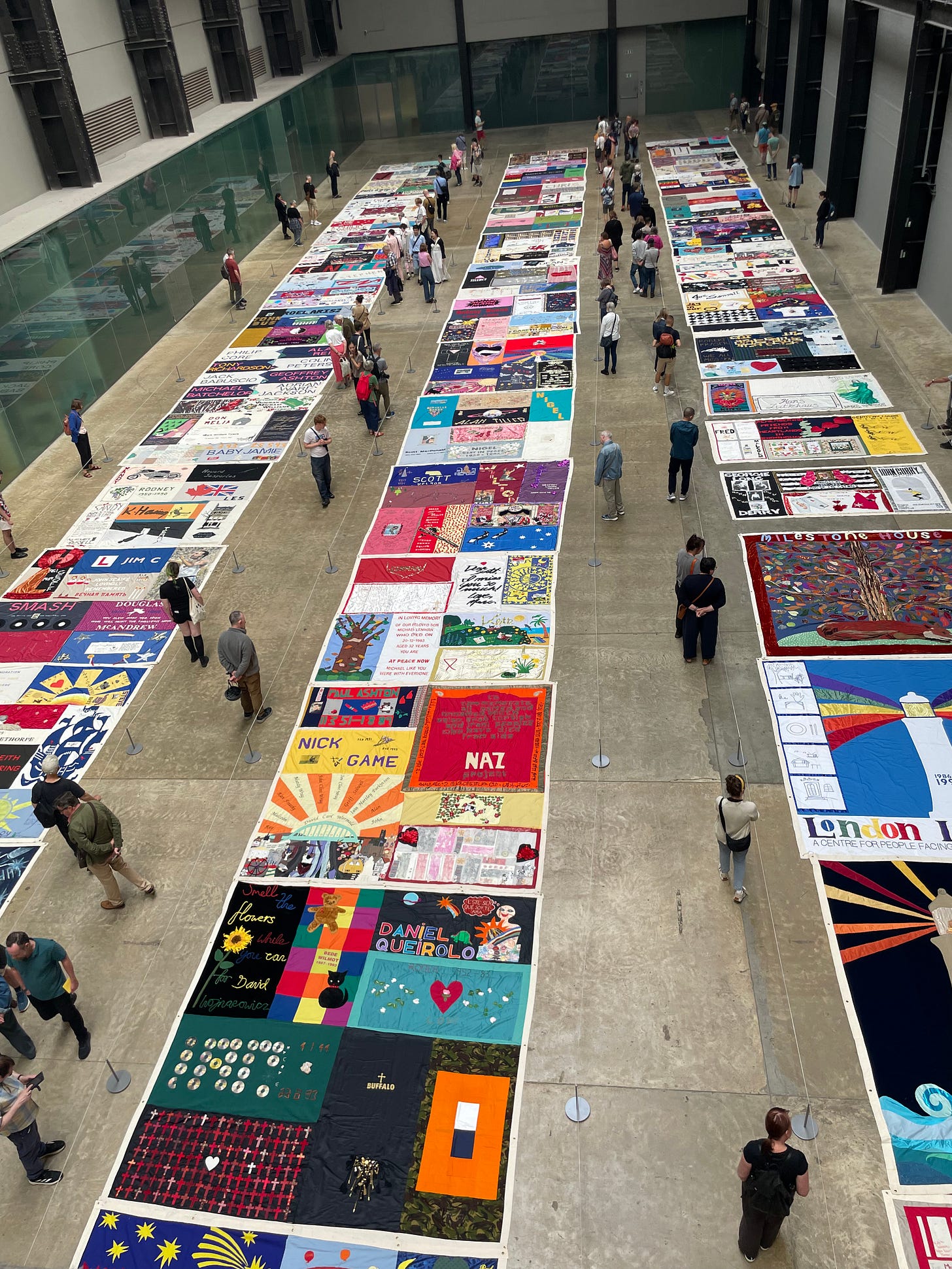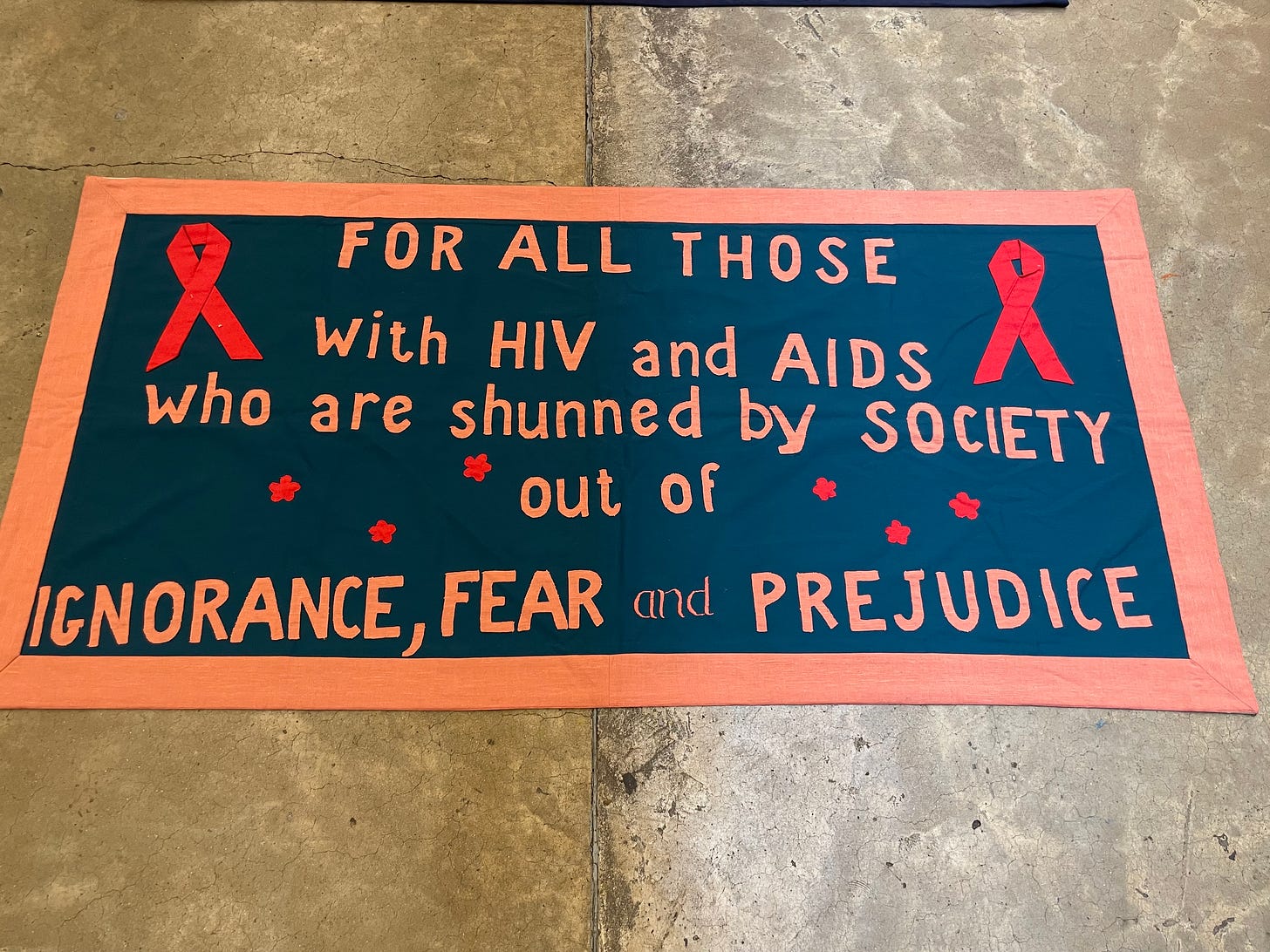Displaying AIDS, Remembering pandemics.
The UK AIDS Quilt is the nearest thing we have to a memorial to the pandemic. All the more pity then that after a rare appearance at Tate Modern it has now been returned to storage.
Visiting Tate Modern’s Turbine Hall to view the UK AIDS Memorial Quilt last week was the closest I will come as a medical historian to a pilgrimage. In 1987, while working as a journalist in Washington DC, I was fortunate to see the US version of the quilt when it was briefly displayed on the National Mall. But by the time I returned to Britian in 1990, the UK version had been put into storage. Since then, it has had only two public outings, in June 1994 at Hyde Park Corner, and in 2021 at the European Aids conference at the ExCeL centre in London. The exhibition at Tate Modern from June 12-16 was the third.
I do not know how long it took the Tate to curate the exhibition but, presumably, it was made easier by the fact that, unlike the US AIDS quilt, the UK panels were never sewn into a single quilt, allowing the panels to be laid side by side in three rows that stretch the length of the Turbine Hall. The result has to be seen to be believed: no photograph can do justice to the quilt’s scale or the sense of loss contained in the intricately collaged fabrics. Walking beside the panels as shafts of sunlight fell on the Tate’s soaring concrete walls, I felt as if I had entered a secular cathedral and the panels were flagstones.
Each lovingly stitched panel is imbued with the sweat and tears of its maker. In the 1980s and early 1990s, when the panels were made, homophobia was widespread, meaning many victims of AIDS could only identified by their first names. Collectively, it is hard to imagine a more affecting testament to love, loss and the struggle against prejudice.
Doing justice to each of the 12 foot-by-12 foot panels would take several posts but if I had to choose one it would be the panel dedicated to Richard Chappell, who died of HIV/AIDS on January 3, 1992. Embroidered with brightly coloured spring flowers and the legend “Never Forget”, it contains the following stanza from Siegfried Sassoon’s poem At Daybreak.
Spirit of purity, he stands
As once he lived in charm and grace
I may not hold him in my hands
Nor bid him stay to heal my sorrow
Only his fair, unshadowed face
Abides with me, until tomorrow.
We cannot know what was in the mind of the panel’s maker when he chose those poignant lines but by selecting a poem by Sassoon, one of our most celebrated war poets, the panel cannot help but underline the parallels between the fallen of Flanders and the fallen of the retrovirus. All of which begs the question, why has it taken until now for the UK AIDS quilt to be displayed by a leading art institution? And when will a permanent home be found for it?
Similar questions bedevil the US AIDS quilt. Comprising 50,000 panels and weighing 54 tons, it is the largest piece of community art in the world and the weightiest memorial to any pandemic in history. Yet after touring the US for several years, the quilt is now in storage in San Francisco and the panels can only be viewed virtually.
AIDS is not the only pandemic to have inspired artistic productions. In the wake of the 14th-century Black Death, artists decorated churches and the tombs of victims with macabre images of dancing skeletons, a reference to the mania for dancing that gripped towns and villages in the path of the plague bacillus. And by the 16th century, the recurrent European experience of plague had spurred a veritable artistic cottage industry, with portrait painters like Albrecht Dürer and Frans Hals depicting wealthy patrons holding skulls and other memento mori as reminders of their mortality.
Covid-19 has also inspired similar acts of remembrance, from the Covid Chronicle, composed of 36 metre-squared panels designed by artists from around the world, to the National Covid Memorial Wall on Albert Embankment decorated with heart-shaped dedications to the 240,000 British victims of the coronavirus. Whether painted on a wall or stitched, these productions remind us that Covid-19, like AIDS, was not merely a dramatic event in the lives of individuals but a disaster that affected whole communities. However, judging by the speed with which the Covid pandemic has faded from public memory, it also appears that it is an experience most of us would rather forget. But then, societies have always done a poor job of commemorating pandemics.
For example, despite killing more than 50 million people worldwide, there are hardly any memorials to the 1918-1919 “Spanish influenza” pandemic in Europe or North America. Memorials to the outbreaks of plague and cholera that swept Europe in the seventeenth, eighteenth and nineteenth centuries are similarly rare. And 44 years after Terence Higgins became one of the first British men to die of AIDS, there is still no UK memorial to AIDS.
Why this should be the case is unclear but it may be connected to the fact that pandemics are natural events largely outside of human agency. As a result, they do not lend themselves to compelling moral narratives. As the memory studies scholar Astrid Erll put it in a recent collection interrogating “the forgotten and unforgotten” Spanish flu of 1918-1919: “Who are the perpetrators if the flu is caused by mutations of string of RNA? What could the moral of the story be if victims are claimed randomly?”
Another consideration is that while wars are able to draw on a familiar suite of repertoires and heroic symbols, pandemics have not been sufficiently mediated in our culture. Without such pre-mediation, collective memory struggles to find a consistent shape and form, hampering the ability to incorporate “lessons” for the prevention of future pandemic crises into the present.
This is what makes the UK AIDS panel so important, for without revisiting the quilt and studying the panels regularly, how can we expect the present generation to understand the fear and shame that attended a positive diagnosis of HIV in the 1980s and 1990s? Back then, it was common for the media to refer to AIDS as “the gay plague”. At the time, many gay men were in the closet and their families were unaware of their sexual preferences. Even if they were brave enough to disclose their diagnoses, they were often shunned by their families and treated as pariahs.
To confront this prejudice, in 1987 Cleve Jones, a human rights activist and lecturer based in San Francisco, hit on the idea of painting the names of 40 AIDS victims on placards and hanging them from the balcony of City Hall. He called the exercise the NAMES Project. It was only when the placards were lined up beside each other, that Jones realised they resembled a quilt. What, he wondered, if he were to make a real quilt with each panel measuring the size of an average grave? And what if the panels were displayed at a national landmark? That would be a fitting memorial to the pandemic and, he reasoned, a symbol politicians could not ignore.
His intuition proved correct. The exhibition of the US quilt on the National Mall in 1987 coincided with the second march for lesbian and gay rights and emboldened activists from ACT-UP (Aids Coalition to Unleash Power) to demand fast-track access to anti-retroviral medications and other experimental treatments. The result today is that HIV is no longer considered an automatic death sentence and it is possible to live with the virus for many years.
In the late 1980s, the success of the US AIDS quilt inspired a Scottish activist, Alastair Hume, to set up a UK version of the NAMES Project. Panels were made by partners, family members or colleagues of those who had died of AIDS-related illnesses. When they were finished, the panels were sent to Edinburgh, with documentation about the person commemorated. In all, 385 people are represented on the UK AIDS quilt. However, just 42 quilts and 23 individual panels featured in the display at the Turbine Hall.
It took me a hour to take in the exhibit, pausing to read poignant dedications before retracing my steps to make sure I hadn’t missed anything. Most of panels commemorate gay men but the quilt also represents other people who died from AIDS-related causes, including intravenous drug users and haemophiliacs infected by contaminated blood, many of whom were children. All these years later, the stigma is still palpable – one panel is covered in a white sheet, with a note declaring “the parents do not want this panel shown anywhere.”
The quilt also contains tributes to well-known figures from the worlds of art, photography and music, such as Keith Haring, Robert Mapplethorpe and Freddie Mercury. But every now and again, there is a surprise: I’d forgotten, for instance, that the novelist Bruce Chatwin died of AIDS, as did the actor Denholm Elliot.
Some of the most affecting panels, however, are dedicated to those who were only famous within their own communities and friendship circles, such as the mysterious “Irish Bob”. Every now and again, I would come across a couple crouched beside a panel to an absent friend or colleague. Many were elderly – survivors, presumably, from those grim “plague years”; nearly all were in tears.
Alas, the exhibition - which attracted 200,000 visitors over six days - was all too short and on Monday the quilt was returned to storage, disappointing those unable to make the round trip to London. Not surprisingly, there are now calls for the Victoria and Albert Museum to acquire the quilt so that the panels can be put on permanent display in South Kensington. Another option would be for the Wellcome Collection, which specializes in exhibitions on medical subjects, to devote one of its galleries in Euston Road to the quilt.
But this is not merely about finding the quilt a permanent home. It is about educating the present generation about the on-going risks of HIV. For the pandemic is not over and these days heterosexuals are just as much at risk as gay men. It is also worth remembering that despite the wide availability of anti-retroviral drugs, there is still no vaccine for HIV.
The biggest burden of the disease is born by Africa, where an estimated 26.5 million people are currently living with HIV and last year some 380,000 died from complications of the virus and associated conditions, such as tuberculosis. However, because of the cuts to USAID programmes ordered by Trump and Musk earlier this year and the pausing of US President's Emergency Plan for AIDS Relief, deaths are only likely to grow (in South Africa alone, it has been estimated the US cuts could result in half a million preventable deaths from HIV over the next decade).
Even more reason then, to revisit the experiences of earlier victims of AIDS in the hope of countering – as one panel puts it – a new wave of “ignorance, fear and prejudice”.






